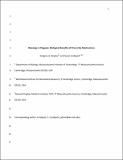| dc.contributor.author | Newby, Gregory Arthur | |
| dc.contributor.author | Lindquist, Susan | |
| dc.date.accessioned | 2016-08-24T18:51:52Z | |
| dc.date.available | 2016-08-24T18:51:52Z | |
| dc.date.issued | 2013-06 | |
| dc.identifier.issn | 09628924 | |
| dc.identifier.uri | http://hdl.handle.net/1721.1/103966 | |
| dc.description.abstract | Prions and amyloids are often associated with disease, but related mechanisms provide beneficial functions in nature. Prion-like mechanisms (PriLiMs) are found from bacteria to humans, where they alter the biological and physical properties of prion-like proteins. We have proposed that prions can serve as heritable bet-hedging devices for diversifying microbial phenotypes. Other, more dynamic proteinaceous complexes may be governed by similar self-templating conformational switches. Additional PriLiMs continue to be identified and many share features of self-templating protein structure (including amyloids) and dependence on chaperone proteins. Here, we discuss several PriLiMs and their functions, intending to spur discussion and collaboration on the subject of beneficial prion-like behaviors. | en_US |
| dc.description.sponsorship | National Science Foundation (U.S.) (NSF Fellowship) | en_US |
| dc.description.sponsorship | Howard Hughes Medical Institute (Investigator) | en_US |
| dc.language.iso | en_US | |
| dc.publisher | Elsevier | en_US |
| dc.relation.isversionof | http://dx.doi.org/10.1016/j.tcb.2013.01.007 | en_US |
| dc.rights | Creative Commons Attribution-NonCommercial-NoDerivs License | en_US |
| dc.rights.uri | http://creativecommons.org/licenses/by-nc-nd/4.0/ | en_US |
| dc.source | Prof. Lindquist via Courtney Crummett | en_US |
| dc.title | Blessings in disguise: biological benefits of prion-like mechanisms | en_US |
| dc.type | Article | en_US |
| dc.identifier.citation | Newby, Gregory A., and Susan Lindquist. “Blessings in Disguise: Biological Benefits of Prion-Like Mechanisms.” Trends in Cell Biology 23, no. 6 (June 2013): 251-259. | en_US |
| dc.contributor.department | Massachusetts Institute of Technology. Department of Biology | en_US |
| dc.contributor.department | Whitehead Institute for Biomedical Research | en_US |
| dc.contributor.approver | Lindquist, Susan | en_US |
| dc.contributor.mitauthor | Newby, Gregory Arthur | en_US |
| dc.contributor.mitauthor | Lindquist, Susan | en_US |
| dc.relation.journal | Trends in Cell Biology | en_US |
| dc.eprint.version | Author's final manuscript | en_US |
| dc.type.uri | http://purl.org/eprint/type/JournalArticle | en_US |
| eprint.status | http://purl.org/eprint/status/PeerReviewed | en_US |
| dspace.embargo.terms | N | en_US |
| dc.identifier.orcid | https://orcid.org/0000-0002-1999-0169 | |
| dc.identifier.orcid | https://orcid.org/0000-0003-1307-882X | |
| mit.license | PUBLISHER_CC | en_US |
